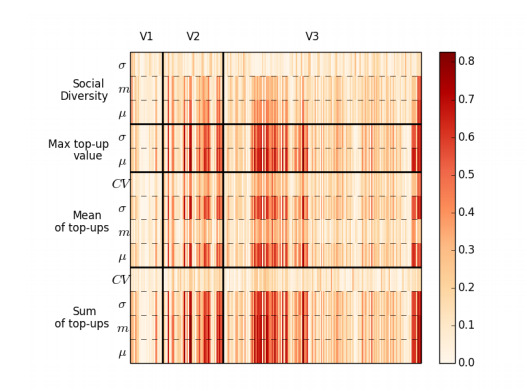How Mobile Phone Data Reveals Food Consumption Patterns in Central Africa
An increasingly important side-effect of the mobile phone revolution is that the big data it generates has become a high-resolution microscope for examining the nature of society. Various teams have shown how mobile phone data reveals patterns of commuting, criminal activity and even human reproductive strategies.

Now Adeline Decuyper at the Université catholique de Louvain in Belgium, and a few pals, say they have used mobile phone usage patterns in a Central African country to determine food consumption patterns. They say the work suggests that mobile phone data could be a valuable tool for monitoring food security in low and middle-income countries.
Decuyper and co began with two datasets. The first is a ground truth survey of food consumption among 7500 households in a Central African country throughout 2012, carried out by the World Food Programme. (The team do not say which country they have studied but a cursory study of the data suggests that it is Rwanda.)
The survey contains 486 questions about the demographics of the household members, the characteristics of the home shelter and household income as well as many specific questions related to food consumption, such as the number of times each type of food was consumed in the last seven days, difficulties in accessing food throughout the year and so on.
The second dataset is a record of all calls for a significant portion of the population from one large mobile phone carrier. Each record includes the caller and callee ID, the cell tower initiating the call and the date and time. The dataset also includes the history of airtime credit purchases from the same population of users.
The hypothesis that Decuyper and co investigate is that the pattern of airtime credit purchases reflects the pattern of food consumption and so can therefore be used as a proxy for this in future.
To find out, they divide the population into geographical areas of between 10,000 and 50,000 inhabitants. They then assign a home location to each mobile phone user in this area based on the place where they make the most calls. For each user, they also plotted their airtime credit purchase behaviour, showing how much they bought and how often.
Finally, they compared the sum of airtime expenses of each individual with various food consumption variables. For example, they compared airtime expenses with how often people ate high-value foods such as sugar and sweets or low value foods such as cassava or sorghum.
The results make for interesting reading. Decuyper and co found that airtime purchases are significantly correlated with the consumption of high-value food items such as vitamin rich vegetables, rice, bread, sugar and fresh meat.
They also found that there was little correlation between airtime purchases and broadly cultivated items such as cassava and beans.
That’s interesting because the high-value items generally have to be bought in the market whereas the low value items tend to be grown at home. “Therefore this study is compatible with a new hypothesis: expenditure in mobile phone top up is proportional to the expenditure in food in the markets,” conclude Decuyper and co.
That hypothesis is backed up by the discovery of a negative correlation between airtime expenses and the consumption of white sweet potato, which is a very cheap and broadly cultivated item. “This suggests that when people can afford to, they will reduce their consumption of sweet potato,” say the team.
The results suggest that mobile phone data could become a hugely important tool for the real-time monitoring of food consumption patterns. The idea is that this kind of data could warn of food shortages and potential national crises, as they occur.
That’s a hugely important function, particularly in parts of the world where surveys are time-consuming, costly and sometimes impossible to carry out. Useful stuff!
Ref: arxiv.org/abs/1412.2595 : Estimating Food Consumption and Poverty indices with Mobile Phone Data
Keep Reading
Most Popular
Large language models can do jaw-dropping things. But nobody knows exactly why.
And that's a problem. Figuring it out is one of the biggest scientific puzzles of our time and a crucial step towards controlling more powerful future models.
The problem with plug-in hybrids? Their drivers.
Plug-in hybrids are often sold as a transition to EVs, but new data from Europe shows we’re still underestimating the emissions they produce.
Google DeepMind’s new generative model makes Super Mario–like games from scratch
Genie learns how to control games by watching hours and hours of video. It could help train next-gen robots too.
How scientists traced a mysterious covid case back to six toilets
When wastewater surveillance turns into a hunt for a single infected individual, the ethics get tricky.
Stay connected
Get the latest updates from
MIT Technology Review
Discover special offers, top stories, upcoming events, and more.